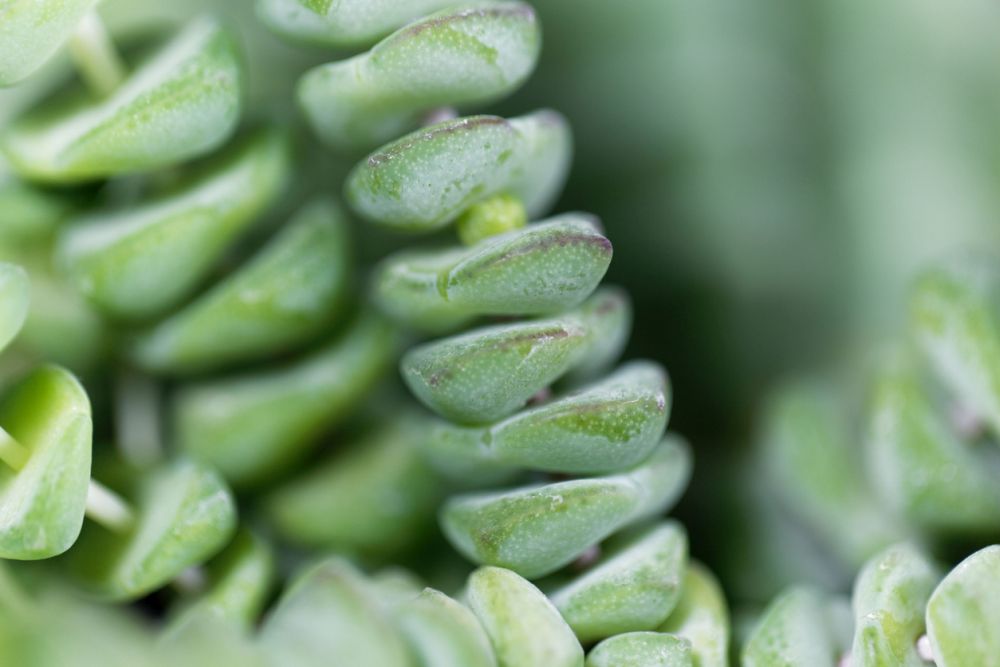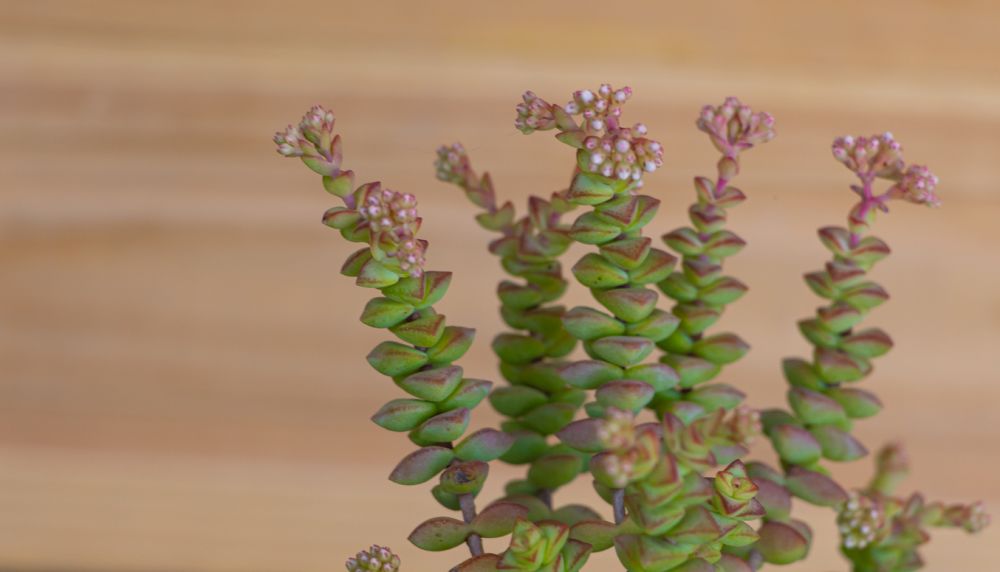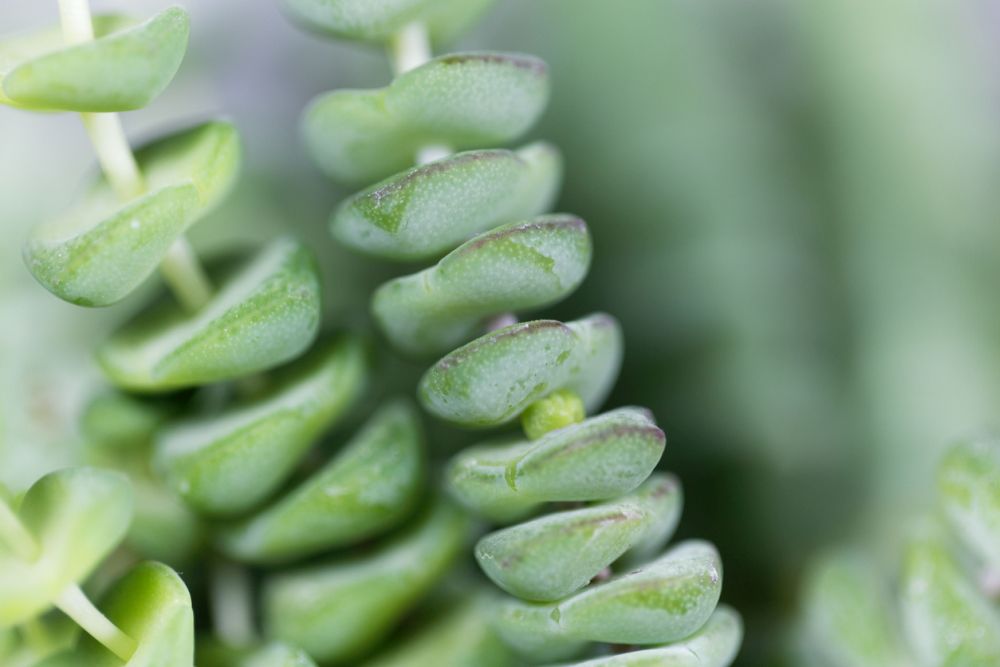Crassula Rupestris Care: Tips on Growing & Caring for the Baby's Necklace Vine
The Crassula Baby's Necklace is a gorgeous succulent species from the Crassulaceae family with honed adaptations for an indoor setting. It's a houseplant that stuns many gardeners for its trailing vines that hold leaves growing in a matchless pattern and resemble beads.

In this guide, we've rounded upwardly the elementary caring tips y'all need to grasp, to brand your Crassula Rupestris houseplant accept an aureola that's beyond compare.
More Facts Near the Baby's Necklace Vine
The Baby'due south necklace Vine is a S African native that looks impeccable even at its worst. Information technology's a hardy delicious with crafty ways to vanquish neglect. Even subsequently hit maturity, the houseplant remains petite with an average acme of 12' inches. It grows upwards then spreads all over the container as information technology ages.
Its star-shaped leaves grow in a spiral pattern effectually the stems and have a rose-ruby-red tone on the edges, making the foliage own a novel stature. Y'all'll also notice it going by these other names beyond many gardening stores:
- Kebab Bush
- Rosary found
- Concertina plant
- Dewdrop vine
The Baby's Necklace Vine borrows its botanical name from the Latin phrase—Crassus—which means thick and fleshy. And that depicts how fluffy and stunning the foliage could get equally it grows older. Apart from the average superlative, the leaves will abound from 1′ to one.5′ inches alpine, while the blooms could span up to 0.25" inches during the flowering season.
Crassula Rupestris Caring Tips
Flowering & Fragrance
Apart from its thick oval-shaped leaves, this succulent institute will yield a few flowers during summer. They're star-shaped and grow in clusters. Most will have a stake pink to white tone and die off once the blooming season is over.
During the growing season, the leaves will course varying shades with a blend of yellow and cherry-red, depending on the light conditions which we'll look at shortly. The reddish and xanthous tone tends to dominantly appear on the tips of the leaves.
Lite & Temperature
Succulents thrive nether the full lord's day fairly well. But for a radiant tone on the leafage, you want to place the foliage somewhere with some shade. Expose your Crassula Rupestris plant to the directly sun at a gradual stride to protect the leaves from burning. The intense rut would cause the institute to have some ugly patches that are hard to treat. And information technology's no wonder why the Baby's Necklace Vine is mostly grown indoors.
When it'due south nighttime the succulent volition enjoy libation temperatures ranging from 10 to 12 degrees Celsius. During the daytime, keep the room temperature at 21 degrees Celsius. To maintain its dense growth and brilliant tone, keep the growing medium close to a window that lets in enough light. If information technology's growing indoors, the Kebab Bush plant will demand about 4-half-dozen hours of light each day for information technology to bloom and look wholesome.
With a staggering preference for USDA hardiness zones 9 to 12, yous want to overwinter this succulent peculiarly if you want to run across it bloom during the side by side growing season. While the Jade institute which happens to exist in the same species prefers low humidity atmospheric condition, you lot can abound the Kebab Bush under slightly high moisture levels.
Other species in the Crassulaceae tin can tolerate modest frost weather condition, but well-nigh die if the temperatures are extremely low. If your winter seasons are dark and long, you can brand the best use of grow lights to assistance the plant with chlorophyll production. During summer, a southward-facing window would suffice.
Soil & Transplanting
Well-nigh succulents tin can grow without hurdles with the commercially sold cactus mix, or the normal potting soil that's optimized for drainage. And since they take adaptations to help them store h2o, any excess moisture getting stuck in the soil for too long could crusade grave harm to the roots.
You, therefore, desire to make sure the potting mix is permeable enough to allow backlog water to laissez passer through drainage holes right beneath the growing pot. You tin can purchase the commercial cactus mix, so amend information technology with coarse, sandy soil. Using perlite would help reach the aforementioned results. Brand sure to top-dress the soil with mulch so it tin help retain some moisture.
Utilize a pH meter to cheque whether your Kebab Bush plant is growing in soil that's preferably neutral to slightly acidic. As a miniature and slow-growing houseplant, at that place won't be an alarming reason for transplanting it anytime soon afterward propagating it. Simply if at that place's an intense need for that, carry out the exercise during warmer months. After transplanting, avoid leaving it in drenched soil for too long. Soggy soil causes the roots to rot.
Watering & Feeding
Aforementioned every bit other succulents commonly grown by homeowners, the Babe'south Necklace Vine can't tolerate the adverse effects of overwatering. Space out the watering intervals and neglect it when information technology'south winter since the growth hormones will go into dormancy effectually this season.
It'due south hard for this succulent to recover from root rot. And it'south more reason why the 'soak and dry' method tends to be a suitable choice for this houseplant. There'due south technically no solid schedule for watering your Kebab Bush plant. Its watering needs depend on the temperature and surrounding humidity levels.
Check whether the first few inches of the topsoil are entirely dry before watering again to protect the roots from rotting. Your succulent houseplant would also exist decumbent to fungal infections if it gets stuck in wet soil for longer hours. During summer you want to adhere to watering intervals of about 7-10 days, thereabout. Simply when wintertime cheque-in, you want to stretch the intervals out a fiddling farther, say, 10-14 days.
Common Pests & Diseases to Watch Out for

Succulents such equally the Baby's Necklace Vine are sternly decumbent to the effects of overwatering. Most species in the Crassulaceae family are oft infested with pests such as aphids, mealybugs, and spider mites, especially when grown indoors. Synthetic-free products such as neem oil would help suppress the numbers if the infestation is massive.
For spider mites, yous can rub isopropyl alcohol on the affected areas using cotton swabs. Place the growing medium somewhere far from kids and pets since the leaves of this delicious houseplant have a pasty sap with high toxicity levels. The sap from the plant could pb to skin irritation or breadbasket upsets when ingested.
How to Propagate the Babe'due south Necklace Vine

Like almost other succulents, propagating the Babe's Necklace Vine is much easier using stem cuttings than seedlings. You can too choose to use leafage cuttings. To run the propagation practise and get a rewarding yield, make sure to:
- Dissect a few leaves or stem cuttings from the mother plant.
- Make certain the cuttings prove no signs of wilting or fungal infections.
- Leave the cuttings exterior for an entire day so the open wounds can dry up and class a callus that protects them from communicable diseases.
- Prepare the potting mix, ideally using tips used to brand cactus mixes for succulents. Use soil that drains water quite well.
- Plant the cuttings and avoid keeping the growing medium somewhere with direct sun rays.
- The root organisation volition begin to form within 2 weeks.
- Water it at least twice a week to speed up the sprouting stage.
- Once the cuttings begin to take shape, reduce the watering intervals to once a calendar week.
- Yous likewise want to introduce it to more light access at a gradual pace.
Source: https://www.diys.com/babys-necklace-vine/
0 Response to "Crassula Rupestris Care: Tips on Growing & Caring for the Baby's Necklace Vine"
Post a Comment